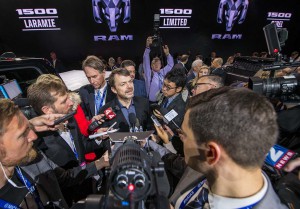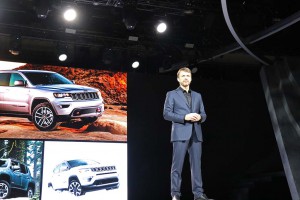
New Fiat Chrysler CEO Mike Manley is not sliding into a cushy job, rather it is a position that faces several difficult challenges in the near and long term.
The head of Fiat Chrysler’s European, Mideast and African business operations reportedly has stepped down, the apparent departure of Alfredo Altavilla kicking into high gear what could become a period of significant turmoil in the automaker’s senior ranks touched off by the unexpected departure of long-time CEO Sergio Marchionne over the weekend.
The 66-year-old Marchionne, who brought Fiat in as a white knight to save Chrysler after its 2010 bankruptcy, was replaced over the weekend by Michael Manley after suffering a grave decline in health following seemingly routine shoulder surgery last week.
The 54-year-old Manley was considered the front-runner to replace Marchionne when he retired nearly a year from now, but the unexpected shake-up will put plenty of pressure on the new CEO to hold things together while also moving ahead with the new FCA five-year plan Marchionne unveiled barely two months ago. Altavilla was seen as one of the other senior execs positioned to succeed Marchionne and it remains to be seen if his departure could be followed by others.
(Manley in as FCA CEO as Marchionne suffers sudden health crisis. Click Here for the story.)
What’s clear is that Marchionne will be a hard man to replace. While the British-born Manley has stepped into the Italian-born and Canadian-educated exec’s role as Chrysler CEO, there were two other key jobs that also had to be filled. Louis Camilleri was named the new CEO at Ferrari, the sports car brand that FCA spun off with Marchionne also at its head. And Suzanne Heywood is the new chairperson at CNH Industrial, the commercial vehicle, agricultural and construction equipment company spun off by Fiat ahead of its merger with Chrysler.
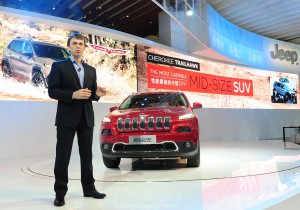
Manley oversaw the explosion of sales at Jeep, which was less than 1 million just a few years ago, and is now more than 2 million annually.
But FCA is the big dog among that group, and Manley’s challenge will be to prove he can make it hunt. His very name is a suiting metaphor for the executive, according to several people who know him. Manley exudes a tough and macho look and style. “He’s the type who could toss back a few pints at a soccer match,” said one source, “but you would know not to bet against him because he’s already done his homework and knows who’s most likely to win.”
Like Marchionne, who was almost never seen wearing anything but a trademark black sweater, Manley is comfortable in leathers and jeans, and was apt to join in on the many field events Jeep holds each year to develop close ties to loyal customers, such as its annual pilgrimage up the Rubicon Trail, one of the most rugged off-road routes in the country.
Manley came into what was then known as DaimlerChrysler AG in 2000. He survived the break-up of that flawed “merger-of-equals,” as well as the short-lived and disastrous takeover by venture fund Cerberus that eventually ended with Chrysler plunging into bankruptcy. Even before that, in 2009, Manley was named head of the Jeep division. He later added Chinese and Asian market oversight before switching his attention to the Ram truck division, as well as Jeep.
As head of the two brands, Manley made himself about as indispensable as anyone at FCA could have been among the tight team reporting to Marchionne. As with domestic rivals General Motors and Ford, pickups provide the overwhelming bulk of FCA’s global earnings. But Jeep has been gaining traction, no surprise considering it has more than tripled sales under his guidance, with global numbers that should nip 2 million this year.
Ironically, Jeep should be doing better, according to some analysts. It effectively created the personal use SUV market with the original Cherokee, but stood by as other brands, such as Ford, GM and Toyota better capitalized on the shift away from passenger cars to light trucks – SUVs today accounting for half the American market and a growing share of global sales.
That said, Jeep builds just one of every 17 utility vehicles sold around the world. The target for the new five-year plan is to boost that to one in 12 and, while it’s not a formal corporate target, Manley said his personal goal is to eventually have up to one in five – which would likely translate into Jeep alone selling north of 6 million utes annually.
Not everything went as smoothly as hoped for. Jeep took far longer than expected to get a production operation going in China and sales have since lagged expectations – Manley suggesting that there was a need to “change the brand’s perception” there from a maker of exclusive specialty vehicles to more mainstream SUVs. The addition of a new three-row model, the Jeep Commander, he told TheDetroitBureau.com, should help.
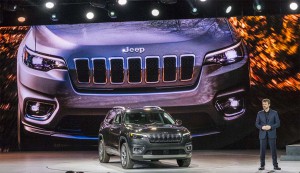
Manley, at the introduction of the Jeep Chrerokee in Geneva, drove a lot FCA's profits in recent years.
In his previous role, Manley could nonetheless position himself as the guy routinely delivering the bulk of FCA’s sales and profits. Going forward, he will have to worry about brands that aren’t nearly living up to their expectations. That includes Alfa Romeo and Maserati, the other two marques that will anchor FCA’s global push. Maserati will remain a relative niche player, albeit growing as it expands to include luxury SUVs. The big challenge is Alfa which was expected to deliver 400,000 annual sales under the previous five-year plan, but barely topped 100,000.
“The original five-year plan wasn’t wrong,” Alfa and Maserati brand chief Tim Kuniskis said during an interview with TheDetroitBureau.com last month. “We said we’d sell 400,000 (Alfas a year) and we will. It’s just taking longer to get there,” in part, he said, because Alfa has shifted product plans to emphasize SUVs, rather than sedans, reflecting global market trends.
Alfa – and Maserati – will be equally important to Manley’s FCA as Jeep and Ram because the two Italian brands will anchor Fiat Chrysler’s belated push into electrification. Every model they sell will, over the course of the five-year plan, be offered with some form of battery propulsion, from mild hybrid up to pure electric. Alfa, in fact, will use a plug-in hybrid system for its new flagship, the 700-horsepower 8C.
(For more on what the new 5-year-plan holds for Jeep, Ram, Alfa and Maserati, Click Here.)
There are plenty of major accomplishments one can credit to Sergio Marchionne, starting with the turnaround at Fiat he set in motion when named CEO there in 2004, and the survival of Chrysler. At the Milan event where the five-year plan was unveiled, the former chairman revealed he had ticked off another prime goal, paying off the last of FCA’s industrial debt. And earnings are strong, as well, hitting a first quarter record of $1.24 billion. The second quarter should also be solid, FCA sales rising 11.2% year-over-year in an otherwise stalled market.
“FCA’s boost in sales shows how far it’s come in addressing the issues that plagued the company in 2017,” said Jenny Acevedo, manager of industry analysis for data service Edmunds. “FCA’s results show you can successfully pivot away from cars in favor of a strong offering of trucks and SUVs and have it work to your advantage.”
But not everyone is so upbeat, and they note that FCA’s belated push into electrification isn’t the only challenge Marchionne left for his successor. The company also has been slow to press into autonomous driving, another technology expected to revolutionize the industry over the coming decade. It may have a viable alternative, however.
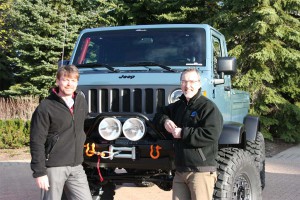
Manley will need to unite the remaining executive leadership, like Pietro Gorlier, Mopar's chief, to move the company forward.
In early 2017, Google spinoff Waymo announced it would purchase about 2,000 Chrysler Pacifica Hybrid minivans for use in its pilot ride-sharing service. Days before the Milan strategy conference, Waymo said it would seek about 60,000 more as it sets out to turn that pilot program into a commercial venture. It is possible FCA will ultimately use Waymo technology in its retail products, as well, challenging other self-driving tech leaders as GM, Ford and Toyota.
(For more on the latest FCA-Waymo deal, Click Here.)
During the Milan briefing and subsequent news conference, Marchionne downplayed what had been, for most of his tenure at FCA, his hardest-sought goal: finding a new alliance or merger partner for FCA. That may have simply been due to glum acceptance of reality. FCA’s romantic overtures had been rejected by an assortment of potential partners, including GM and VW. But the problems that Marchionne identified, including a lack of scale, could still be a critical fault that Manley will have to deal with.
There’s no question that Sergio Marchionne left Fiat Chrysler in far better shape than when he began to merge the two together. But there’s also no doubt that FCA still faces some significant challenges, from the upper floors of management down to the shop floor.
Mike Manley has shown himself to be someone not only unintimidated by challenge, but seemingly excited to take risk head-on. He will have plenty to keep him busy in his new job.


